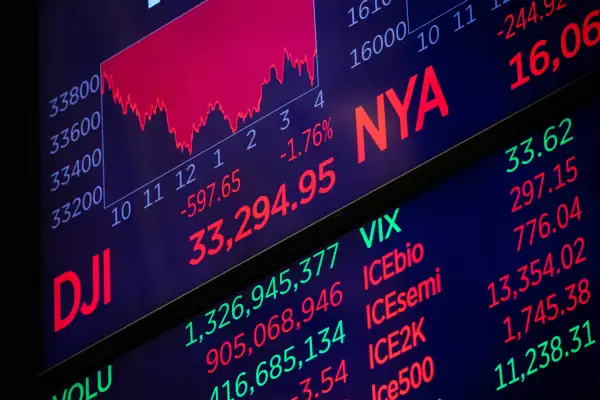What the Stock Market Selloff Means for Your 401(k)
Money is not a client of any investment adviser featured on this page. The information provided on this page is for educational purposes only and is not intended as investment advice. Money does not offer advisory services.

Ideally, you're not checking your 401(k) balance every few hours. But if you're alarmed by how your retirement savings are faring in today's stock market, you're not alone. You might even be wondering if it's time to change your investing strategy.
Financial markets have suffered a major selloff in recent weeks. The S&P 500 — a benchmark commonly used to measure the overall stock market — is down around 19% for the year and dipped into a bear market territory(down 20% from its previous record) during trading on Friday. Meanwhile, the Dow Jones Industrial Average is down 15% for the year, and the tech-heavy Nasdaq Composite has fallen 28% in 2022 as investors take in the Federal Reserve's interest rate hikes and continued geopolitical tensions.
Despite the volatility we've seen so far this year, retirement savers aren't slowing down their 401(k) contributions. In fact, the percentage of a worker's salary being contributed to a 401(k), including both employer and employee contributions, reached a new high of 14% in the first quarter of 2022, according to a recent report from Fidelity Investments. Financial experts tend to recommend trying to get that number to 15%, so seeing the savings rate inch up is a good thing.
Even though watching your 401(k) balance bounce up and down in a volatile market can be scary, acting impulsively on that fear could hurt you in the long run.
"You want to be sure that you're not making any changes to your allocation that could potentially backfire on you," says Mike Shamrell, vice president of thought leadership at Fidelity Investments.
Volatility is normal
The current market has been brutal for many retirement savers, but remember that volatility is a part of investing. If you have a plan in place that aligns with your risk tolerance, goals and timeline, you should be able to weather the current storm in the markets.
Financial advisors say it's important not to make drastic changes to your retirement saving plan, as it's impossible to time when market ups and downs will happen. While there is no predicting stocks' performance on any given day or week, what we do know is that the market's best days tend to occur right around the market's worst days. For example, the S&P 500 was down 3.6% on April 29, which marked one of the worst days of the year for the index. But just a few days later on May 4, the index was up nearly 3% for one of its best days, according to data from J.P. Morgan Asset Management.
Because it's so hard to time the market, experts tend to recommend investors dollar-cost average, which is a strategy that entails investing modest amounts of money at regular intervals, like $100 every month.
If you regularly allocate a percentage of each paycheck to your 401(k), you're already doing that, says Mindy Yu, director of investing at Betterment at Work, Betterment's 401(k) business. And right now, with the price for many financial assets down, it's actually an opportune time to have this strategy in place for many investors as you're able to buy more shares for less money, she adds.
What plunging stocks means for young investors' 401(k)s
While the current market volatility may shock younger investors especially — since they tend to have a higher stock allocation in their retirement accounts — Yu says it's important for them to remember that they also have more time to recover from a market downturn.
"It isn't going to impact them as much over the course of their longer time horizon," she adds.
That's in part thanks to compound interest. This is the interest that you earn on the original amount you invested, plus the interest on interest as that money accumulates over the years.
Here's an example from Fidelity from earlier this year: A $10,000 investment that grows at the S&P 500's historical average return of around 9% per year and compounds annually could grow to $15,386.24 in five years, $23,673.64 in 10 years, $56,044.11 in 20 years, and $132,676.78 in 30 years.
But your money only has a chance to grow like this if you keep it invested. You don't want to put your money on the sidelines — no matter how spooked you may be — and miss out on that compound interest. Let your 401(k) do the work for you in the long term.
... And for investors with a shorter time horizon
When you're nearing or in retirement, market downturns can be scary since you may already be relying on your 401(k) or will be soon.
Still, investors shouldn't make changes to their 401(k)s based on short-term market events, says Mike Shamrell, vice president of thought leadership at Fidelity. Even if you're approaching retirement age, you may need your savings to last multiple decades after you retire, he points out.
"You don't want to be in a position where you pull back and become a little bit more conservative, then you potentially miss out on potential gains if the market rebounds," Shamrell says. "That's why we encourage people to maintain their allocation and stay the course."
That said, now could be a good time to revisit your allocations and ensure that it still aligns with your risk and timeline. Financial advisors tend to recommend that as investors get closer to retirement, they shift some of their allocations away from risky investments, like stocks, into more conservative assets, like bonds.
The exact allocation will depend on your specific situation, but for investors 10 or more years out from retirement, some experts recommend 85% to 95% in stocks and 10% to 15% in bonds, with that ratio shifting to 70% stocks and 30% bonds for those between five and 10 years out from retirement and to 60% in stocks and 40% in bonds for those who are retired or within five years of retiring.
Other advisors prefer a more conservative approach, with 30% or less in equities when you’re within 10 years of retirement, and reducing that further as you get closer, as Money has previously reported.
Target-date funds are often the default option for workers' 401(k)s, for good reason. This type of fund gives you broad exposure to stocks and other asset classes, and also automatically rebalances over time to reduce your risk as you near retirement — so it's possible your 401(k) is already doing much of the work for you.
More from Money:
Why Keeping Your Money in the Stock Market Is Especially Important Right Now
